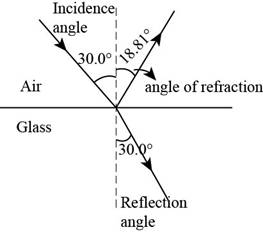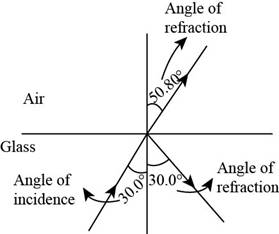
Concept explainers
(a)
The angle of the reflected and refracted rays when light ray incident from the air at angle of incidence
(a)
Answer to Problem 52AP
The angle of reflection is
Explanation of Solution
Given info: The index of refraction of glass is
From, law of reflection, the angle of incidence is equal to the angle of reflection.
Thus, angle of reflection is
From Snell’s law,
Here,
Substitute
The figure below shows the angle of incidence, the angle of reflection and the angle of refraction.

Figure (1)
Conclusion:
Therefore, the angle of reflection is
(b)
The angle of the reflected and refracted rays when light ray incident from the glass at angle of incidence
(b)
Answer to Problem 52AP
The angle of reflection is
Explanation of Solution
Given info: The index of refraction of glass is
From, law of reflection, angle of incidence is equal to angle of reflection.
Thus, angle of reflection is
From, Snell’s law,
Here,
Substitute
The figure below shows the angle of incidence, the angle of reflection and the angle of refraction.

Figure (2)
Conclusion:
Therefore, the angle of reflection is
(c)
The angles of reflection and refraction for all angles of incidence at
(c)
Answer to Problem 52AP
The angle of reflection is same as the angle of incidence and the angle of refraction for rays incident from air onto the air-glass surface is increasing as angle of incidence is increasing. The table for different values of angles is,
| Angle of incidence | Angle of reflection | Angle of refraction |
|
|
|
|
|
|
|
|
|
|
|
|
|
|
|
|
|
|
|
|
|
|
|
|
|
|
|
|
|
|
|
|
|
|
|
|
|
|
|
|
Explanation of Solution
From, law of reflection, the angle of reflection is equal to the angle of incidence. So for all value of angles between
The formula to calculate the angle of refraction is,
From, Snell’s law,
Substitute
Substitute
The remaining values of the angle of refraction can be calculated by the same method.
The table for angle of reflection and angle of refraction for all angles of incidence at
| Angle of incidence | Angle of reflection | Angle of refraction |
|
|
|
|
|
|
|
|
|
|
|
|
|
|
|
|
|
|
|
|
|
|
|
|
|
|
|
|
|
|
|
|
|
|
|
|
|
|
|
|
Conclusion:
Therefore, the angle of reflection is same as the angle of incidence and the of angle of refraction for rays incident from air onto the air-glass surface is increasing as angle of incidence is increasing.
The table for angle of reflection and angle of refraction for all angles of incidence at
| Angle of incidence | Angle of reflection | Angle of refraction |
|
|
|
|
|
|
|
|
|
|
|
|
|
|
|
|
|
|
|
|
|
|
|
|
|
|
|
|
|
|
|
|
|
|
|
|
|
|
|
|
(d)
The angles of reflection and refraction for all angles of incidence at
(d)
Answer to Problem 52AP
The angle of reflection is same as the angle of incidence and the of angle of refraction for rays coming up to the interface through the glass will increase up to angle of incidence
The table for angle of reflection and angle of refraction for all angles of incidence at
|
Angle of incidence(
(
|
Angle of reflection(
|
Angle of refraction(
|
|
|
|
|
|
|
|
|
|
|
|
|
|
|
|
|
|
|
|
|
|
|
|
|
|
|
|
|
|
|
|
|
|
|
|
|
|
|
|
|
Explanation of Solution
From, the law of reflection, angle of reflection is equal to the angle of incidence. So, for all value of angles between
The formula to calculate the angle of refraction is,
From, Snell’s law,
Substitute
Substitute
The remaining values of the angle of refraction can be calculated by the same method.
The formula to calculate the critical angle is,
Here,
Substitute
The angle of incidence is greater than
The table for angle of reflection and angle of refraction for all angles of incidence at
|
Angle of incidence(
(
|
Angle of reflection(
|
Angle of refraction(
|
|
|
|
|
|
|
|
|
|
|
|
|
|
|
|
|
|
|
|
|
|
|
|
|
|
|
|
|
|
|
|
|
|
|
|
|
|
|
|
|
Conclusion:
Therefore, the angle of reflection is same as the angle of incidence and the of angle of refraction for rays coming up to the interface through the glass will increase up to angle of incidence
The table for angle of reflection and angle of refraction for all angles of incidence at
|
Angle of incidence(
(
|
Angle of reflection(
|
Angle of refraction(
|
|
|
|
|
|
|
|
|
|
|
|
|
|
|
|
|
|
|
|
|
|
|
|
|
|
|
|
|
|
|
|
|
|
|
|
|
|
|
|
|
Want to see more full solutions like this?
Chapter 35 Solutions
Physics For Scientists And Engineers With Modern Physics, 9th Edition, The Ohio State University
- The index of refraction for water is about 43. What happens as a beam of light travels from air into water? (a) Its speed increases to 43c, and its frequency decreases. (b) Its speed decreases to 34c, and its wavelength decreases by a factor of 34. (c) Its speed decreases to 34c, and its wavelength increases by a factor of 43. (d) Its speed and frequency remain the same. (e) Its speed decreases to 34c, and its frequency increases.arrow_forwardUnpolarized light in vacuum is incident onto a sheet of glass with index of refraction n. The reflected and refracted rays are perpendicular to each other. Find the angle of incidence. This angle is called Brewsters angle or the polarizing angle. In this situation, the reflected light is linearly polarized, with its electric field restricted to be perpendicular to the plane containing the rays and the normal.arrow_forwardA light ray travels from vacuum into a slab of material with index of refraction n1 at incident angle θ with respect to the surface. It subsequently passes into a second slab of material with index of refraction n2 before passing back into vacuum again. The surfaces of the different materials are all parallel to one another. As the light exits the second slab, what can be said of the final angle ϕ that the outgoing light makes with the normal? (a) ϕ > θ (b) ϕ < θ (c) ϕ = θ (d) The angle depends on the magnitudes of n1 and n2. (e) The angle depends on the wavelength of the light.arrow_forward
- Ethanol (n = 1.36) is poured into a container made of flint glass (n = 1.66). If the light ray in glass incident on the glass-to-liquid boundary makes an angle of 40 degrees with the normal, what is the angle of the corresponding refracted ray with respect to the normal?arrow_forwardA light ray in air is incident on an air-to-glass boundary at an angle of 30.0º and is refracted in the glass at an angle of 21.0º with the normal. Find the index of refraction of the glass.arrow_forwardCarbon tetrachloride (n = 1.46) is poured into a container made of crown glass (n = 1.52). If the light ray in glass incident on the glass-to-liquid boundary makes an angle of 30 degrees with the normal, what is the angle of the corresponding refracted ray with respect to the normal?arrow_forward
- A ray of light travels across a liquid-to-air. If the index of refraction for the liquid is, 1.33 . What is the critical angle at this interface?arrow_forwardA beam of light enters a piece of glass (n = 1.5) from air (n = 1) with an incident angle of 300. Calculate the angle of refraction of the beam of light. Use GRASP.arrow_forwardA light ray traveling in air is incident on one face of a right-angle prism of index of refraction n=1.5 as shown in Fig., and the ray follows the path shown in the figure. Assuming 0 = 55° and the base of the prism is mirrored, determine the angle p made by the outgoing ray with the normal to the right face of the prism. Incoming ray Ourgoing ray 90° -0 Mirror base Select one: O A. 3.09 В. 32° O C. 12.7° D. 19.87° O E. 7.9°arrow_forward
- A light ray in air is incident on an air-to-glass boundary with an angle of incidence of 45.0° with the normal. It is refracted in the glass with an angle of refraction of 22.0° with the normal. What is the index of refraction of the glass?arrow_forwardA beam of light is incident on a hemispherical prism at an angle, theta, as shown in the figure. If the index of refraction of the prism is 1.60, what is the critical angle (in degrees) for no transmitted light out of the bottom of the prism? Assume the index of refraction for air is 1.00 and the index of refraction for the water is 1.33.arrow_forwardA ray of white light traveling through air enters a triangular prism that has an index of refraction of 1.313 for the red end of the spectrum and 1.349 for the violet end and an apex angle of 71.8 degrees. If the ray has an angle of incidence of 60.3degrees with respect to the normal of the interface boundary, what is the angular separation between the red and violet ends of the spectrum within the prism? Measure this in degrees to 3 decimal places.arrow_forward
 Physics for Scientists and Engineers: Foundations...PhysicsISBN:9781133939146Author:Katz, Debora M.Publisher:Cengage Learning
Physics for Scientists and Engineers: Foundations...PhysicsISBN:9781133939146Author:Katz, Debora M.Publisher:Cengage Learning Principles of Physics: A Calculus-Based TextPhysicsISBN:9781133104261Author:Raymond A. Serway, John W. JewettPublisher:Cengage Learning
Principles of Physics: A Calculus-Based TextPhysicsISBN:9781133104261Author:Raymond A. Serway, John W. JewettPublisher:Cengage Learning

